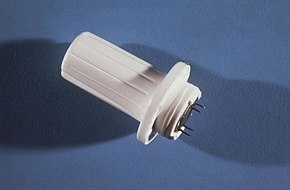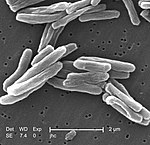|
Tine test
The tine test is a multiple-puncture tuberculin skin test used to aid in the medical diagnosis of tuberculosis (TB). The tine test is similar to the Heaf test, although the Mantoux test is usually used instead. There are various forms of the tine tests which usually fall into two categories: the old tine test (OT) and the purified protein derivative (PPD) tine test. Common brand names of the test include Aplisol, Aplitest, Tuberculin PPD TINE TEST, and Tubersol.[1] ProcedureThis test uses a small "button" that has four to six short needles coated with TB antigens (tuberculin), either an old tuberculin or a PPD-tuberculin. The needles are pressed into the skin (usually on the inner side of the forearm), forcing the antigens into the skin. The test is then read 48 to 72 hours later by measuring the size of the largest papule or induration. Indications are usually classified as positive, negative, or doubtful.[2] Because it is not possible to control precisely the amount of tuberculin used in the tine test, a positive test should be verified using the Mantoux test.[3] PPDTuberculin is a glycerol extract of the tubercle bacillus. Purified protein derivative (PPD) tuberculin is a precipitate of non-species-specific molecules obtained from filtrates of sterilized, concentrated cultures. It was first described by Robert Koch in 1890 and then Giovanni Petragnani.[citation needed] A batch of PPD created in 1939 serves as the US and international standard, called PPD-S.[4] PPD-S concentration is not standardized for multiple-puncture techniques, and should be designed for the specific multiple-puncture system.[5] Comparison to Mantoux testThe American Thoracic Society or Centers for Disease Control and Prevention (CDC) do not recommend the tine test, since the amount of tuberculin that enters the skin cannot be measured.[6] For this reason, the tine test is often considered to be less reliable.[citation needed] Contrary to this, however, studies have shown that the tine test can give results that correlate well to the Mantoux test.[7][8] If a minor reaction is considered doubtful, the OT test is less accurate and may fail to detect TB, producing a false negative.[2] If all doubtful indications are instead classified as positive, there is no significant difference between the OT test, the PPD tine test, or the Mantoux test.[3] Furthermore, the tine test is faster and easier to administer than the Mantoux test and has been recommended for screening children.[9][10] References
|
||||||

